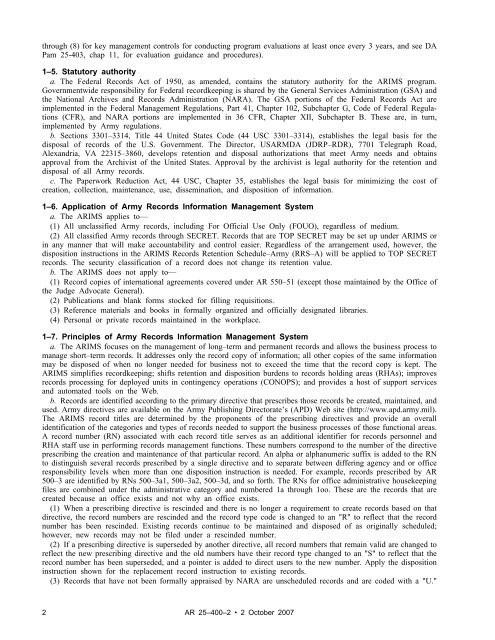The Army Records Information Management System (ARIMS)
The Army Records Information Management System (ARIMS)
The Army Records Information Management System (ARIMS)
Create successful ePaper yourself
Turn your PDF publications into a flip-book with our unique Google optimized e-Paper software.
through (8) for key management controls for conducting program evaluations at least once every 3 years, and see DA<br />
Pam 25-403, chap 11, for evaluation guidance and procedures).<br />
1–5. Statutory authority<br />
a. <strong>The</strong> Federal <strong>Records</strong> Act of 1950, as amended, contains the statutory authority for the <strong>ARIMS</strong> program.<br />
Governmentwide responsibility for Federal recordkeeping is shared by the General Services Administration (GSA) and<br />
the National Archives and <strong>Records</strong> Administration (NARA). <strong>The</strong> GSA portions of the Federal <strong>Records</strong> Act are<br />
implemented in the Federal <strong>Management</strong> Regulations, Part 41, Chapter 102, Subchapter G, Code of Federal Regulations<br />
(CFR), and NARA portions are implemented in 36 CFR, Chapter XII, Subchapter B. <strong>The</strong>se are, in turn,<br />
implemented by <strong>Army</strong> regulations.<br />
b. Sections 3301–3314, Title 44 United States Code (44 USC 3301–3314), establishes the legal basis for the<br />
d i s p o s a l o f r e c o r d s o f t h e U . S . G o v e r n m e n t . T h e D i r e c t o r , U S A R M D A ( J D R P – R D R ) , 7 7 0 1 T e l e g r a p h R o a d ,<br />
Alexandria, VA 22315–3860, develops retention and disposal authorizations that meet <strong>Army</strong> needs and obtains<br />
approval from the Archivist of the United States. Approval by the archivist is legal authority for the retention and<br />
disposal of all <strong>Army</strong> records.<br />
c. <strong>The</strong> Paperwork Reduction Act, 44 USC, Chapter 35, establishes the legal basis for minimizing the cost of<br />
creation, collection, maintenance, use, dissemination, and disposition of information.<br />
1–6. Application of <strong>Army</strong> <strong>Records</strong> <strong>Information</strong> <strong>Management</strong> <strong>System</strong><br />
a. <strong>The</strong> <strong>ARIMS</strong> applies to—<br />
(1) All unclassified <strong>Army</strong> records, including For Official Use Only (FOUO), regardless of medium.<br />
(2) All classified <strong>Army</strong> records through SECRET. <strong>Records</strong> that are TOP SECRET may be set up under <strong>ARIMS</strong> or<br />
in any manner that will make accountability and control easier. Regardless of the arrangement used, however, the<br />
disposition instructions in the <strong>ARIMS</strong> <strong>Records</strong> Retention Schedule–<strong>Army</strong> (RRS–A) will be applied to TOP SECRET<br />
records. <strong>The</strong> security classification of a record does not change its retention value.<br />
b. <strong>The</strong> <strong>ARIMS</strong> does not apply to—<br />
(1) Record copies of international agreements covered under AR 550–51 (except those maintained by the Office of<br />
the Judge Advocate General).<br />
(2) Publications and blank forms stocked for filling requisitions.<br />
(3) Reference materials and books in formally organized and officially designated libraries.<br />
(4) Personal or private records maintained in the workplace.<br />
1–7. Principles of <strong>Army</strong> <strong>Records</strong> <strong>Information</strong> <strong>Management</strong> <strong>System</strong><br />
a. <strong>The</strong> <strong>ARIMS</strong> focuses on the management of long–term and permanent records and allows the business process to<br />
manage short–term records. It addresses only the record copy of information; all other copies of the same information<br />
may be disposed of when no longer needed for business not to exceed the time that the record copy is kept. <strong>The</strong><br />
<strong>ARIMS</strong> simplifies recordkeeping; shifts retention and disposition burdens to records holding areas (RHAs); improves<br />
records processing for deployed units in contingency operations (CONOPS); and provides a host of support services<br />
and automated tools on the Web.<br />
b. <strong>Records</strong> are identified according to the primary directive that prescribes those records be created, maintained, and<br />
used. <strong>Army</strong> directives are available on the <strong>Army</strong> Publishing Directorate’s (APD) Web site (http://www.apd.army.mil).<br />
<strong>The</strong> <strong>ARIMS</strong> record titles are determined by the proponents of the prescribing directives and provide an overall<br />
identification of the categories and types of records needed to support the business processes of those functional areas.<br />
A record number (RN) associated with each record title serves as an additional identifier for records personnel and<br />
RHA staff use in performing records management functions. <strong>The</strong>se numbers correspond to the number of the directive<br />
prescribing the creation and maintenance of that particular record. An alpha or alphanumeric suffix is added to the RN<br />
to distinguish several records prescribed by a single directive and to separate between differing agency and or office<br />
responsibility levels when more than one disposition instruction is needed. For example, records prescribed by AR<br />
500–3 are identified by RNs 500–3a1, 500–3a2, 500–3d, and so forth. <strong>The</strong> RNs for office administrative housekeeping<br />
files are combined under the administrative category and numbered 1a through 1oo. <strong>The</strong>se are the records that are<br />
created because an office exists and not why an office exists.<br />
(1) When a prescribing directive is rescinded and there is no longer a requirement to create records based on that<br />
directive, the record numbers are rescinded and the record type code is changed to an "R" to reflect that the record<br />
number has been rescinded. Existing records continue to be maintained and disposed of as originally scheduled;<br />
however, new records may not be filed under a rescinded number.<br />
(2) If a prescribing directive is superseded by another directive, all record numbers that remain valid are changed to<br />
reflect the new prescribing directive and the old numbers have their record type changed to an "S" to reflect that the<br />
record number has been superseded, and a pointer is added to direct users to the new number. Apply the disposition<br />
instruction shown for the replacement record instruction to existing records.<br />
(3) <strong>Records</strong> that have not been formally appraised by NARA are unscheduled records and are coded with a "U."<br />
2 AR 25–400–2 2 October 2007

















